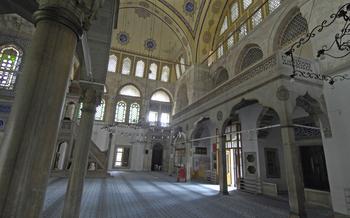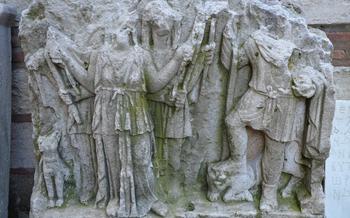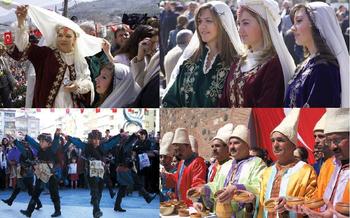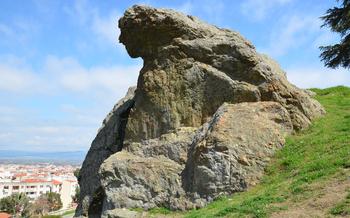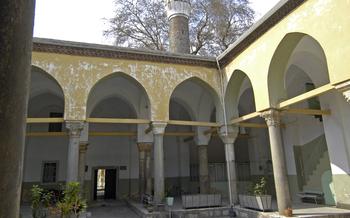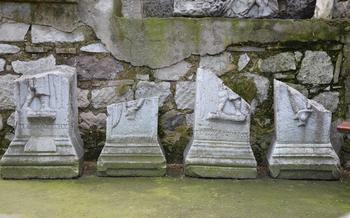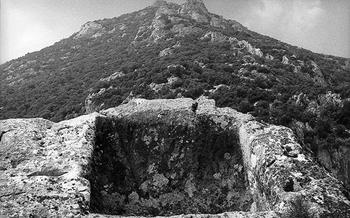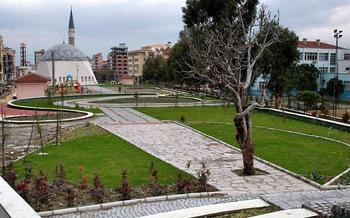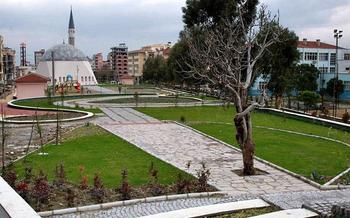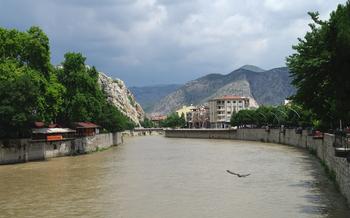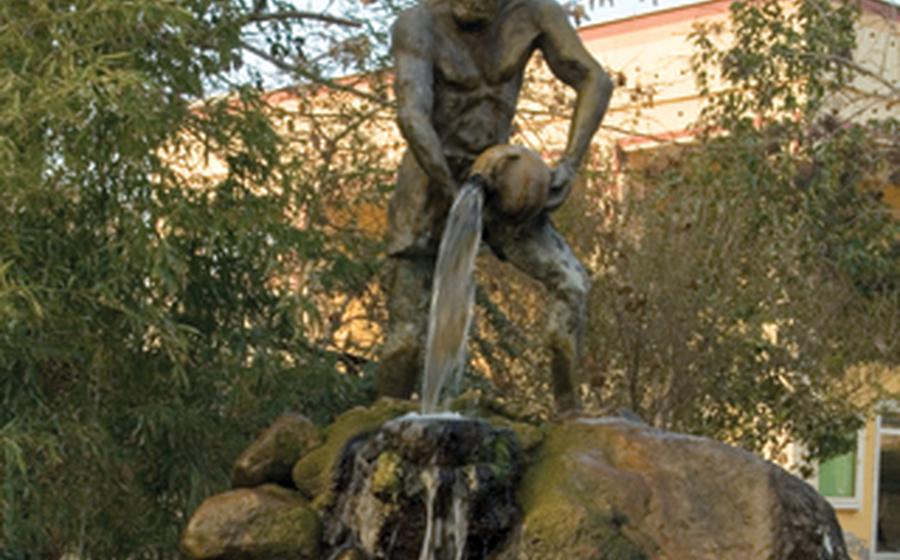
Manisa Tarzanı Statue
- Manisa Tarzanı Statue: A Tribute to a Turkish Legend
- Historical Roots: Unveiling Manisa's Rich Past
- Manisa Museum: A Treasury of History and Art:
- Manisa's Culinary Delights: A Taste of Turkish Cuisine
- Majestic Mountains: Embracing Nature's Splendor:
- Sipylus National Park: A Haven for Nature Lovers:
- Ancient Theaters: Echoes of History and Performance
- Manisa Vilayet Konağı: A Symbol of Ottoman Architecture
- Muradiye Mosque: Exploring Ottoman Splendor
- Manisa's Festivals and Events: A Vibrant Cultural Scene
- Local Handicrafts: Unearthing Artisanal Treasures
- Manisa's Thermal Springs: A Soothing Retreat
- Accommodation Options: Finding Your Perfect Stay
- Transportation Hub: Exploring Manisa's Connectivity:
- Insider Tip: Discovering Hidden Gems
Manisa Tarzanı Statue: A Tribute to a Turkish Legend
In the heart of Turkey's Manisa province lies a unique tribute to a legendary figure who captured the imagination of the Turkish people: the Manisa Tarzanı Statue. This towering bronze monument stands as a testament to the life and legacy of Naim Süleymanoğlu, a renowned weightlifter who earned the nickname "Manisa Tarzanı" for his extraordinary strength and agility.
Born in 1967 in the small village of Pazarcik in Manisa, Naim Süleymanoğlu was destined for greatness from an early age. His exceptional athletic abilities were evident from his childhood, and he soon began to train as a weightlifter. With dedication and perseverance, he quickly rose through the ranks, becoming a national champion at the age of
Süleymanoğlu's international success came in 1984 when he won a gold medal at the Olympic Games in Los Angeles. This victory marked the beginning of a remarkable career that would see him become one of the most decorated weightlifters in history. Over the next decade, he went on to win three more Olympic gold medals, as well as numerous world and European championships.
Süleymanoğlu's achievements not only brought glory to Turkey but also earned him the admiration and respect of people around the world. He became a national hero, inspiring countless young athletes to pursue their dreams. His incredible strength and determination earned him the nickname "Manisa Tarzanı," a fitting tribute to his superhuman abilities.
Historical Roots: Unveiling Manisa's Rich Past
Manisa boasts a rich historical tapestry, dating back to ancient civilizations that left an indelible mark on the region. In ancient times, the city was known as Magnesia ad Sipylum and served as a significant center in the Ionian League. The majestic Mount Sipylus, looming over Manisa, holds a prominent place in Greek mythology as the home of the grieving Niobe, whose tears turned into the mountain's streams.
Excavations in the ancient city have unearthed impressive ruins, including the well-preserved Magnesia Theater, a testament to the city's cultural significance. The theater, built in the Hellenistic period, could accommodate up to 20,000 spectators and hosted performances of Greek tragedies and comedies.
Manisa is also home to the Manisa Museum, which houses a remarkable collection of artifacts from various eras, including impressive sculptures, pottery, and jewelry. The museum provides a glimpse into the rich history and cultural heritage of the region, showcasing the artistic achievements of past civilizations.
Manisa Museum: A Treasury of History and Art:
The Manisa Museum is a treasure trove of historical artifacts and artistic masterpieces, showcasing the rich cultural heritage of the region. The museum's collection spans various eras, from ancient civilizations to the Ottoman period, providing a glimpse into Manisa's diverse past.
Highlights of the Museum's Collection: Among the museum's highlights are a collection of ancient sculptures, including the iconic "Weeping Woman" statue, believed to date back to the Hellenistic period. The museum also houses a significant collection of Roman mosaics, offering a glimpse into the artistic traditions of the Roman Empire.
Architectural Features and History of the Building: The museum building itself is a testament to the region's architectural heritage. Constructed in the early 20th century, the building boasts a blend of Ottoman and European architectural styles, reflecting the cultural influences that shaped the city. Its grand entrance and intricate details make it an attraction in its own right.
Visitor Information: The Manisa Museum is open to the public from Tuesday to Sunday, offering visitors the opportunity to delve into the region's rich history and culture. Admission fees are minimal, and guided tours are available for a deeper understanding of the exhibits.
Tips for Visitors: To make the most of your visit to the Manisa Museum, plan to spend at least a couple of hours exploring the exhibits. Wear comfortable shoes as there is quite a bit of walking involved. Also, remember to bring your camera to capture the beauty of the artifacts and the building itself.
Manisa's Culinary Delights: A Taste of Turkish Cuisine
Manisa's culinary scene is a vibrant tapestry of flavors, showcasing the region's rich history and cultural influences. Among the must-try dishes is the iconic "Manisa kebabı," a succulent lamb kebab grilled to perfection and served with a tantalizing blend of spices. The tender meat, marinated in a flavorful yogurt sauce, simply melts in your mouth, leaving you craving for more.
Another culinary gem of Manisa is the legendary "mesir macunu," a centuries-old confection that holds a special place in Turkish culture. This unique paste, made from a blend of 41 different spices and herbs, is believed to possess healing properties and is often consumed during the annual Mesir Festival. Its aromatic fragrance and sweet, slightly spicy taste make it a truly unforgettable treat.
To savor the authentic flavors of Manisa, venture into the heart of the city and explore the local restaurants and food markets. Here, you'll find an array of culinary delights, from traditional Turkish dishes to modern fusion creations. Whether you prefer to dine in a cozy family-run eatery or indulge in a lavish feast at a fine-dining establishment, Manisa's culinary scene has something to satisfy every palate.
For vegetarians and those with dietary restrictions, Manisa offers a wealth of options. From fresh salads and grilled vegetables to hearty lentil soups and stuffed vine leaves, there's no shortage of delicious and nutritious dishes to choose from. Don't hesitate to ask the locals for recommendations or inquire about any specific dietary needs.
As you embark on your culinary adventure in Manisa, embrace the opportunity to engage with the friendly locals and learn about their culinary traditions. They'll be delighted to share their favorite dishes and provide insights into the cultural significance of food in this vibrant region.
Majestic Mountains: Embracing Nature's Splendor:
Manisa boasts a stunning natural backdrop, dominated by the majestic Mount Sipylus. This natural wonder offers breathtaking panoramic views and a sanctuary for nature enthusiasts. Embark on a rejuvenating hike along the scenic trails, immersing yourself in the tranquility and beauty of the surroundings. Explore the diverse flora and fauna, including endemic species that call Mount Sipylus their home.
The surrounding mountains, such as Bozdağ and Yamanlar, beckon adventurers with challenging treks and unforgettable camping experiences. Embrace the wilderness, breathe in the fresh mountain air, and witness the stunning sunsets that paint the sky in vibrant hues. Plan your hiking or camping trip meticulously, ensuring you have the necessary gear and supplies for a safe and enjoyable journey.
Sipylus National Park: A Haven for Nature Lovers:
Nestled in the picturesque folds of Mount Sipylus, Sipylus National Park beckons nature enthusiasts with its mesmerizing landscapes and diverse ecosystems. As you step into this natural wonderland, the rich tapestry of flora and fauna will captivate your senses. From vibrant wildflowers carpeting the meadows to soaring birds of prey circling the cliffs, the park pulsates with life.
One of the park's highlights is its collection of endemic plant species, found nowhere else on Earth. These botanical treasures, adapted to the unique microclimates of Sipylus, add an extra layer of intrigue to the park's already captivating beauty.
Lace up your hiking boots and embark on a journey through the park's intricate network of trails. As you traverse the rugged terrain, the stunning vistas will leave you breathless. Gaze upon the majestic Mount Sipylus, its towering peak piercing the azure sky, and let the panoramic views soothe your soul.
For those with a passion for birdwatching, Sipylus National Park is an ornithological paradise. With its diverse habitats, the park attracts a wide variety of bird species, including majestic eagles, colorful woodpeckers, and melodious songbirds. Capture the symphony of their calls as they flit through the trees, creating a captivating soundscape.
Beyond its natural wonders, Sipylus National Park is steeped in mythological associations and legends. As you wander through the park, let your imagination soar as you uncover the ancient tales that have shaped its cultural significance. From the tragic Niobe legend to the heroic tales of ancient Greek mythology, the park's landscapes are imbued with a sense of enchantment.
Before you embark on your adventure in Sipylus National Park, be sure to familiarize yourself with the park regulations and entrance fees. Respect the park's natural environment and follow the guidelines to ensure its preservation for generations to come. Let your visit to Sipylus National Park be a testament to your love for nature and your commitment to its conservation.
Ancient Theaters: Echoes of History and Performance
The ancient theaters of Manisa stand as testaments to the city's rich cultural heritage. These magnificent structures, built during the Greek and Roman eras, once hosted theatrical performances, musical concerts, and public gatherings. The most notable theater is the Magnesia Theater, situated on the southern slopes of Mount Sipylus. Constructed in the 2nd century BC, this theater could accommodate up to 25,000 spectators. Its impressive cavea (seating area) is divided into two sections, with a diazoma (horizontal passageway) separating them. The stage building, adorned with intricate carvings and sculptures, is a testament to the artistry of the ancient Greeks.
Attending a performance or event at one of Manisa's ancient theaters is a truly immersive experience. The acoustics are exceptional, allowing the performers' voices to carry throughout the entire theater. The atmosphere is electric, as the audience is transported back in time to the days when these theaters were bustling with activity. Whether you're a history buff, a theater enthusiast, or simply seeking a unique cultural experience, Manisa's ancient theaters are not to be missed.
Manisa Vilayet Konağı: A Symbol of Ottoman Architecture
Manisa Vilayet Konağı, also known as the Manisa Government House, stands as a testament to the grandeur of Ottoman architecture. Constructed in the 19th century, it served as the administrative center of the Manisa province during the Ottoman Empire. The building's imposing presence reflects the power and influence of the Ottoman government.
With its intricate stonework, elegant arches, and decorative details, Manisa Vilayet Konağı showcases the architectural prowess of the Ottoman Empire. The building's design incorporates traditional Islamic motifs, blending harmoniously with European influences. The spacious interiors, adorned with ornate ceilings and marble floors, exude an aura of opulence and sophistication.
Today, Manisa Vilayet Konağı is a protected historical monument and serves as a government building. Visitors are welcome to admire its architectural beauty from the exterior or inquire about the possibility of guided tours to explore its interiors. By appreciating the grandeur of this building, one can gain a deeper understanding of the rich history and cultural heritage of Manisa.
Muradiye Mosque: Exploring Ottoman Splendor
Manisa's architectural heritage extends beyond its ancient theaters and natural wonders, encompassing magnificent Ottoman structures like the Muradiye Mosque. Built in the 16th century during the reign of Sultan Murad III, this mosque stands as a testament to the empire's architectural prowess and religious devotion.
The Muradiye Mosque showcases a blend of classical Ottoman and Seljuk architectural styles. Its striking dome, intricate tilework, and elegant minarets reflect the refined aesthetics of the period. The interior of the mosque is equally impressive, adorned with ornate calligraphy, colorful Iznik tiles, and a serene ambiance that invites contemplation and prayer.
Beyond its architectural beauty, the Muradiye Mosque holds historical significance as a center of Islamic learning and worship. It was once part of a larger complex that included a madrasah, a library, and a caravanserai, serving as a hub for religious and intellectual pursuits.
To fully appreciate the mosque's grandeur, visitors should take the time to explore its various features, including the main prayer hall, the courtyard, and the minarets. Modest dress is recommended as a sign of respect for the mosque's religious significance.
Whether you're a history buff, an architecture enthusiast, or simply seeking spiritual tranquility, the Muradiye Mosque offers a glimpse into the rich cultural and religious heritage of Manisa.
Manisa's Festivals and Events: A Vibrant Cultural Scene
Manisa's cultural heritage shines through its vibrant festivals and events, offering a glimpse into the region's rich history and traditions. Throughout the year, the city comes alive with celebrations that showcase local customs, art, and music.
One of the most notable events is the Manisa Mesir Festival, held annually in May. This centuries-old festival celebrates the healing properties of "mesir macunu," a traditional herbal paste made from 41 different spices. The festival features a colorful parade, traditional music and dance performances, and the distribution of "mesir macunu" to attendees.
Another highlight is the Manisa International Sculpture Symposium, held every two years. This prestigious event brings together renowned sculptors from around the world to create stunning works of art that are displayed throughout the city. Visitors can witness the creative process firsthand and admire the finished sculptures that adorn Manisa's public spaces.
Cultural enthusiasts should not miss the Manisa International Music Festival, held annually in July. This festival features performances by renowned musicians and orchestras from Turkey and abroad, showcasing a diverse range of musical genres. Concerts are held in various venues across the city, creating a lively atmosphere throughout the festival period.
For those seeking a more traditional experience, the Manisa Traditional Handicrafts Fair is a must-visit. Held annually in September, this fair showcases the exquisite craftsmanship of local artisans, who display and sell their handmade goods, including carpets, pottery, jewelry, and textiles. Visitors can witness traditional techniques and purchase unique souvenirs to cherish their time in Manisa.
These are just a few of the many festivals and events that make Manisa a vibrant cultural destination. By immersing themselves in these celebrations, visitors can gain a deeper understanding of Turkish traditions and experience the warmth and hospitality of the local people.
Local Handicrafts: Unearthing Artisanal Treasures
Manisa is renowned for its rich tradition of handicrafts, reflecting the region's cultural heritage and artistic prowess. Explore the vibrant local markets and workshops to discover an array of unique souvenirs and treasures.
- Traditional Crafts:
- Witness the intricate art of carpet weaving, where skilled artisans create colorful masterpieces using traditional techniques passed down through generations.
- Admire the delicate lace embroidery, a specialty of Manisa, showcasing intricate patterns and motifs that adorn clothing, linens, and home décor.
-
Delve into the world of ceramics, where local potters craft beautiful pottery using local clay, often featuring traditional designs and vibrant glazes.
-
Souvenirs and Gifts:
- Take home a piece of Manisa's culinary heritage with mesir macunu, a traditional sweet paste made from a blend of spices and herbs, believed to have medicinal properties.
- Find unique souvenirs made from olive wood, a local specialty, including intricate carvings, kitchenware, and decorative items.
-
Discover hand-painted tiles, featuring vibrant designs and patterns, perfect for adding a touch of local charm to your home décor.
-
Supporting Local Artisans:
- By purchasing local handicrafts, you directly support the talented artisans who keep these traditions alive.
-
Visit local workshops and markets to meet the artisans, learn about their techniques, and gain a deeper appreciation for their work.
-
Unforgettable Experiences:
- Engage in hands-on workshops to learn traditional crafts like carpet weaving or pottery, creating your own unique souvenir while immersing yourself in the local culture.
- Embark on a guided tour of the local markets, where you can interact with artisans, learn about their craft, and find hidden treasures.
Manisa's Thermal Springs: A Soothing Retreat
Manisa is blessed with an abundance of natural thermal springs, renowned for their therapeutic properties since ancient times. These springs have been a source of healing and relaxation for centuries, attracting visitors seeking relief from various ailments. Immerse yourself in the warm, mineral-rich waters of these springs and let your worries melt away.
Historical records indicate that the healing powers of Manisa's thermal springs were recognized as early as the Roman era. The Romans built elaborate bathhouses and spas around these springs, where people could come to bathe and rejuvenate. Over the centuries, the tradition of bathing in these springs continued, and today, modern-day spa facilities and wellness centers have been established to provide visitors with a luxurious and therapeutic experience.
Whether you're seeking relief from chronic pain, muscle tension, or simply looking to unwind and pamper yourself, Manisa's thermal springs offer the perfect escape. Take a dip in the soothing waters, indulge in a massage, or enjoy a rejuvenating spa treatment. Let the natural healing properties of these springs work their magic, leaving you feeling refreshed, revitalized, and rejuvenated.
Accommodation Options: Finding Your Perfect Stay
Manisa offers a diverse range of accommodation options to suit every traveler's needs and budget. From budget-friendly hostels and guesthouses to comfortable mid-range hotels, and luxurious resorts, there's something for everyone. For those seeking a unique and authentic experience, traditional Turkish guesthouses and boutique hotels offer a glimpse into the local culture and hospitality.
When choosing a place to stay in Manisa, consider the location that best fits your interests and itinerary. If you plan to explore the city's historical sites and museums, opt for a hotel in the city center. For those seeking a more relaxed and tranquil stay, consider hotels situated on the outskirts of the city, offering stunning views of the surrounding mountains and countryside.
To find the best deals and book your stay, take advantage of online booking platforms and travel websites. Many hotels offer special discounts and promotions, especially during the off-season. Additionally, consider seeking recommendations from locals or fellow travelers for hidden gems and lesser-known accommodations that may offer a more personalized and memorable experience.
Transportation Hub: Exploring Manisa's Connectivity:
Manisa boasts excellent connectivity, making it easily accessible by various means of transportation. The city is well-connected to major cities in Turkey and beyond through its international airport, which offers direct flights to several destinations. For those traveling by rail, Manisa is served by the Turkish State Railways, providing convenient connections to other parts of the country. If you prefer road travel, Manisa is conveniently located along major highways, allowing for scenic drives and easy access by bus or car.
Once in Manisa, getting around the city is a breeze. The public transportation system is reliable and efficient, with buses and minibuses covering most areas of the city. For those who prefer a more personalized experience, taxis are readily available and affordable.
To make the most of your stay, consider embarking on organized tours or day trips from Manisa. These tours offer a hassle-free way to explore the surrounding attractions, including historical sites, natural wonders, and charming villages. Whether you choose to explore Manisa independently or with the help of a tour guide, the city's transportation infrastructure ensures a smooth and enjoyable journey.
Insider Tip: Discovering Hidden Gems
Beyond the well-known attractions, Manisa holds a treasure trove of hidden gems waiting to be discovered. Venture off the beaten path to uncover these lesser-known wonders that offer a glimpse into the city's rich history and vibrant culture. Explore the picturesque villages nestled amidst rolling hills, each with its unique charm and traditions. Discover ancient ruins and historical sites that tell the story of civilizations past. Indulge in culinary delights at local markets, savoring authentic flavors and delicacies known only to the locals. Embrace the warmth of Manisa's people, who are always eager to share their stories and traditions with visitors. Whether it's a hidden mosque with stunning architecture, a secluded natural paradise, or a traditional craft workshop, Manisa rewards those who seek its hidden treasures. Embrace the spirit of adventure and let the city reveal its secrets, creating unforgettable moments that will linger long after your departure.
